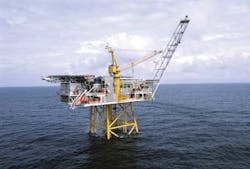Statoil has brought onstream three of its conveyor belt of fasttrack subsea tiebacks. Two are in the North Sea and one in the Norwegian Sea, where the company has also started work on a new project in the Åsgard area.
Vigdis North-East is a reservoir on the northern limits of the Vigdis field in the North Sea, discovered in 2009. Recoverable volumes are estimated at around 37 MMboe. A seabed template with four wells is connected to the existing facility for Vigdis on the Snorre A platform, 7 km (4.3 mi) to the north. The anticipated field life is over 15 years, with overall development costs around $739 million.
Statoil did not issue a cost estimate for Stjerne, a 13-km (8-mi) four-well tieback to the North Sea Oseberg platform, but did say that the final figure was $86 million below the amount forecast at the time of sanction. Drilling was delayed at the start due to a rig change. The 49-MMboe Stjerne field eventually entered production 39 months after its discovery in late 2009. However, Statoil's goal is to reduce its fasttrack field development times to an average of 30 months.
Skuld in the Norwegian Sea is the company's sixth tie-in to the Norne field production ship. It takes in 90 MMboe (mostly oil and gas) from the Fossekall and Dompap discoveries, and should extend Norne's lifespan till at least 2030. Costs here were around $1.8 billion. Statoil plans further exploration and development in the Norne area, and is looking at ways of lifting recovery from the existing satellites.
To the south, Statoil and its partners have committed to the $600-million Smorbukk South Extension project, which involves adding a new subsea template to tie in 16.5 MMboe of reserves to the Åsgard A semisubmersible platform. Initial plans call for one multi-lateral well with two oil-producing branches, and one gas injection well to maintain reservoir pressure as oil is produced. Drilling should start early in 2015 followed by start-up later that year.
Lack of available capacity in the Åsgard gas pipeline system had held up work on other gas discoveries in the area. However, the planned long-distance Polarled pipeline and its various branches in the Norwegian Sea have opened up possibilities. The partners in Zidane in license PL435 are set to take advantage by connecting the field's gas to Statoil's Heidrun platform, 15 km (9.3 mi) to the southeast, via a subsea template with slots for four production wells. A new treatment module will be installed on the platform to prepare Zidane's gas for export through Polarled.
Wintershall proves oil in Hibonite
Wintershall has maintained its strong run of exploration successes in Scandinavian waters by proving oil in the Hibonite structure in the Danish North Sea, 278 km (172 mi) west of Esbjerg. The location in the 5/06 license is 7 km (4.3 mi) north of the Ravn oil field, which the company successfully appraised in 2009. In both cases the reservoir is formed by upper Jurassic Heno sandstones. The jackupNoble George Sauvageau, was next due to switch to nearby license 4/06a to drill another exploratory well for Wintershall on the Spurv prospect.
At present there appears to be 100 MMbbl of in-place oil, and potential for a joint development of Hibonite with Ravn. All other Danish oil field developments to date have been operated by the established triumvirate of DONG, Hess, and the DUC consortium. PA Resources found commercial oil fairly recently in the Broder Tuck and LilleJohn structures, but the company's financial difficulties appear to have held back progress there.
In the southern Norwegian Sea, DONG has discovered more oil and gas close to the Trym field. A well drilled by the jackupMaersk Giant in 65 m (213 ft) of water in license PL 147 intersected a 159-m (521-ft) hydrocarbon column in the Sandnes and Bryne formation.
Statoil's latest appraisal well on Johan Sverdrup in the Norwegian North Sea proved that the giant field extends into a third license, PL502. The well encountered a 13.5-m (44-ft) oil column in the Jurassic, and the results suggest potential for further upside west of Johan Sverdrup. Later this year Statoil plans to drill the Cliffhanger prospect in PL265.
Elgin/Franklin back in action
Total has restarted operations in the Elgin/Franklin area of the UK central North Sea.
Production had been shut in for almost a year following a gas leak from the G4 well on March 25, 2012. Investigations revealed that the cause was a type of stress corrosion unique to the well, induced from a non-producing chalk layer 1,000 m (3,281 ft) above the reservoir.
The partners have agreed to permanently abandon several Elgin/Franklin wells and to evaluate others for safety risks. In the meantime, present production is only at half the fields' combined potential at close to 70,000 boe/d. To restore the level of performance prior to the incident, redevelopment will be needed, including drilling of new infill wells. The associated West Franklin Phase II development, involving installation of a new platform, remains on schedule for start-up next year.
At Yme, a planned field redevelopment in the Norwegian North Sea, the partners have agreed to remove and scrap the MOPUstor production platform supplied and installed by SBM Offshore following continuing delays to start-up caused by structural defects. The topsides will be removed, with the Yme license holders taking ownership of the in-situ subsea structure while they assess development alternatives involving a new topsides solution. SBM will receive an upfront settlement payment of $470 million and will manage transportation and scrapping of the removed facility.
Statoil has had no known problems with its platform on the Huldra field in the North Sea, which entered service in 2001. The steel jacket facility has a design lifetime of 20 years, but Huldra itself faces depletion by 2015. So, Statoil is prepared to listen to offers for re-use of the platform elsewhere. It was built as a high-pressure/high-temperature gas-condensate production installation but could be adapted to handle light and heavy oils without the need for major investments, the company claims.
BP starts latest review of Clair potential
BP and its partners have sanctioned a new two-year appraisal drilling program on the giant Clair oil field 75 km (46.6 mi) west of Shetland. The first of the five planned wells is drilling ahead and seven more could follow, depending on results. The aims of the $500-million campaign are to clarify overall reservoir volumes, distribution and fluid characteristics; to evaluate techniques that could improve recovery from the field; and to gain information for potential new developments and links to the current Clair Ridge project, targeting part of the field north of the existing production facilities.
One new UK project going ahead is TAQA Bratani's redevelopment of Pelican, a subsea tieback to the Cormorant Alpha platform. This will involve drilling new development wells. The project qualifies for the UK's brownfield tax allowance for older North Sea fields.
Offshore Articles Archives
View Oil and Gas Articles on PennEnergy.com





